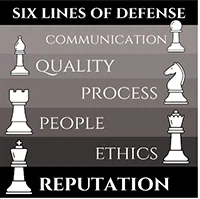 |
| Tim O'Brien |
When dealing with a crisis, one of the first places to start is by identifying where in proximity to the organization’s reputation it lies, so, like a cancer, you can isolate it and neutralize it before it grows.
This “Lines of Defense” messaging model illustrates the six lines of defense the crisis communications team must identify and protect as the crisis unfolds. This model helps the team focus on the severity of the situation while also, at the same time, prioritize its messages.
The objective is to identify and isolate the crisis situation at its source through clear understanding of the proximity of the source of the crisis to the organization’s core reputation. Once this can be achieved, all communications strategy, messaging and efforts can be focused on that area to prevent the situation from spreading deeper into the lines of defense.
The deeper the situation spreads, the more serious the crisis is and the potential for greater damage to the organization.
A simple example would be a scenario where viral photos of an employee surface in which that employee was wearing offensive clothing and carrying offensive signage at a public event.
Perhaps this employee was also wearing a piece of clothing that clearly exhibited the company’s logo, implicating the company. The photo goes viral, and the news media scrambles to determine if the individual is a current employee of the organization, and they seek comment from the organization. Activist groups and others may form a groundswell to pressure the organization to fire the employee and condemn that employee’s stance on the controversial issue. These groups may go even further and ask the organization to take a controversial stance of its own on the issue. As this transpires, reporters may then seek to identify any other employees in the organization who share similar views.
If the organization can quickly determine that only this one individual (who is not a senior member of management) is involved, and can say it has addressed the situation internally, it will have effectively isolated the crisis at the upper lines of defense.
However, if the crisis is one in which members of the senior management team are as vulnerable as that one employee, then the severity of the crisis deepens. This would cut to the foundation of the Lines of Defense model at “Organization’s Reputation.” Once it reaches that level, there is the risk of longer-term damage to the organization’s reputation, and requires more decisive and immediate actions.
 |
First Line of Defense – Communication: Includes all communication, from informal communications to key stakeholders, to formal communications, as well as external communications that could extend to public relations. This would also include packaging, advertising and social media activity. Some of these crises may center on non-communication, allegations of false, contradictory or confusing claims. The organization should then focus on its strengths in the following areas to respond: adherence to systems, processes and policies for communication and reporting; commitment to transparency; a positive track record in this area.
Second Line of Defense – Quality: Includes service or product quality, including quality of packaging, maintenance of facilities and equipment, and the appearance and maintenance of the physical plant. The organization would then focus on its strengths in the following areas to respond: the organization's past performance in the quality of service or manufacturing; its processes and adherence to them; the quality of management and its commitment to preserving the organization's integrity through the practice of solid, ethical decision-making.
Third Line of Defense – Systems, Processes & Policies: Could include a crisis originating from a faulty procedure at the organization or its operations which led to the crisis. In such instances, the organization would focus on identifying the problem-procedure or protocol and correcting it. In other instances, the issue could be one where communication of sound policies and processes was the core issue leading to lack of adherence to a solid protocol. In this case, the focus would then be to shift this from a “process and policy” problem to a “communications” one, positioning it further away from the core of the organization. In all cases, the organization would want to emphasize its commitment to preserving the company's integrity through the practice of solid, ethical decision-making, along with of course, its track record in adherence to sound process.
Fourth Line of Defense – The Organization’s People: Could include a crisis centered on situations of flagrant incompetency, poor judgement, patterns of unresponsiveness to customers/consumers and questionable activities of managers or staff members. In such instances, the organization should focus on its strengths in the following areas to respond: the systems and processes in place to address such problems; the commitment of management to investigate and resolve any personnel issues; and its commitment to preserving the organization's integrity through the practice of solid, ethical decision-making.
Fifth Line of Defense – Institutional Ethics: Would include a crisis involving management scandal or unethical activities of employees that may not be an isolated instance. In such instances, the organization should focus on its strengths in the following areas to respond: oversight responsibilities of the Board of Directors, senior advisors, a parent company or organization; systems and processes in place to address such problems; quality control processes; a commitment to transparency and accountability; and the commitment of the organization's management to investigate and resolve any problems.
The Core – Organization’s Reputation: The corporate reputation is at the core of all Crisis Communications activity. It will benefit or suffer based on how effectively or ineffectively the crisis situation is managed. To be sure, all crises involve the organization's corporate reputation to some extent, particularly as rooted in the character of its leadership.
***
Tim O’Brien, founder of O’Brien Communications (OBrienCommunications.com), is the author of The Essential Crisis Communications Plan: A Crisis Management Process that Fits Your Culture. This article is an excerpt from the book.


 There’s a fine line between newsjacking and taking advantage, aka ambulance chasing. Our job as PR professionals is to tread it carefully.
There’s a fine line between newsjacking and taking advantage, aka ambulance chasing. Our job as PR professionals is to tread it carefully. PR firms need to be mindful of ways their work product may be protected by the attorney-client privilege whenever working with a client’s internal legal team or its external legal counsel.
PR firms need to be mindful of ways their work product may be protected by the attorney-client privilege whenever working with a client’s internal legal team or its external legal counsel. Manuel Rocha, former US ambassador and intenational business advisor to LLYC, plans to plead guilty to charges that he was a secret agent for Cuba.
Manuel Rocha, former US ambassador and intenational business advisor to LLYC, plans to plead guilty to charges that he was a secret agent for Cuba. CEO mentoring is an often-overlooked aspect of why CEOs are able to make good decisions, and sometimes make bad ones—all of which intersects with the role and duties of a board.
CEO mentoring is an often-overlooked aspect of why CEOs are able to make good decisions, and sometimes make bad ones—all of which intersects with the role and duties of a board.  How organizations can anticipate, prepare and respond to crises in an increasingly complex world where a convergent landscape of global challenges, threats and risks seem to arrive at an unrelenting pace.
How organizations can anticipate, prepare and respond to crises in an increasingly complex world where a convergent landscape of global challenges, threats and risks seem to arrive at an unrelenting pace.


 Have a comment? Send it to
Have a comment? Send it to 
No comments have been submitted for this story yet.